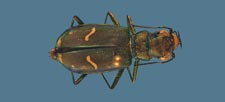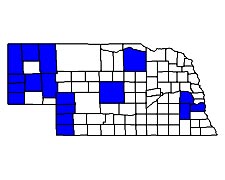
| Cicindela purpurea audubonii LeConte |
| Adult Length: 12.5 to 17 mm |
| Appearance: Adults exhibit two distinct color variations. In all cases a middle band is present, which terminates shortly before the elytral margin. An apical mark is always present, but dots in the humeral, posthumeral, and subapical area may or may not be present. The ground color of the adults may be entirely black, or greenish to purplish red with green margins on the elytra. In non-black individuals the head and pronotum are often reddish in color with or without green along the edges. There is usually a blackish patch around the middle band, which in very rare cases may be expanded to cover most of the posterior half of each elytron. The frequency of black individuals to green varies geographically and possibly seasonally. During surveys in 2004, the ratio of black to green individuals in Sioux County was around 1 to 2, while in Scotts Bluff County it was around 1 to 1. It is unknown what causes these black morphs, but there is most likely a genetic component. Such dimorphism is not rare in tiger beetles, and it is well known in C. scutellaris rugifrons (parts of its distribution), C. plutonica (a western species), and more rarely in C. scutellaris lecontei. |
| Similar Species: Though this species could be confused with C. limbalis or C. denverensis, it is easily distinguished by the fact that the middle band terminates short of the elytral margin. |
| Biology: This species occurs on hard-packed soils. In Nebraska it occurs in grasslands, particularly among bare soil patches and along trails. Though it can be found on hard-packed sandy soils, it is most consistent on loess, clay, and sandy clay soils. |
| Adult Life History: Adults emerge from the pupa in late August and September and are often active into October before overwintering. Unusual spells of warm weather may draw out a few individuals as two were collected in central Wisconsin in mid-November under such conditions. Activity resumes in March and April, with peak numbers from early April to mid-May. Numbers then decline rapidly and adults are rare by the beginning of June, except in the higher elevations of the Nebraska panhandle, where adults may linger well into June. Adults are quite skittish and often fly into vegetation when alarmed. It is a spring-fall species. |
| Larval Life History: Eggs are laid mostly in April and May. Most larvae reach the third instar by fall before overwintering. Pupation occurs during July and August of the following summer. Larval burrows can be found along trails and among bare patches in grasslands in hard-packed soils. |
| Biogeography: This species has been recorded from widely scattered locations across Nebraska and appears to be most consistent in the panhandle. It is common across much of Sioux and Scotts Bluff Counties. In North America it occurs from Nova Scotia and central British Columbia to northern Georgia, Oklahoma, Arizona, and central California. Five subspecies have been described. The federally endangered C. ohlone of California is similar and likely evolved from C. purpurea. |



